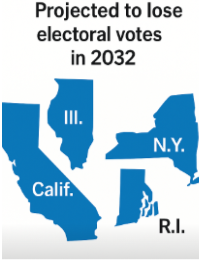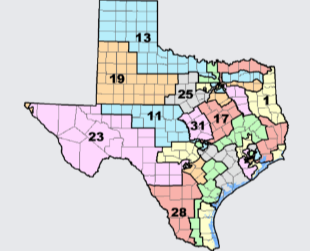Hispanic support for deportations is rising as Trump holds steady and Musk’s image falls, putting message discipline at the center of the 2026 strategy.
What to Know
- Population growth is shifting political power to Texas, Florida, and other states with a predominantly red population.
- California, New York, and several swing states are expected to lose electoral votes after 2030.
- Democrats’ 2024 winning map would shrink by nearly one-third.
- The DNC is urging early investments in red states ahead of the next census.
- Without a southern strategy, Democrats risk a lasting electoral disadvantage.
The political map of the 2030s is already taking shape as Americans move south and west. According to a New York Times analysis of new census projections, population growth in red states like Texas and Florida is quietly rewriting the rules of presidential politics. Both states are projected to gain a combined five electoral votes after the 2030 census, while Utah and Idaho will each add one.

Screenshot from The New York Times
On the losing end are the Democratic power centers of California and New York, which together could forfeit four votes. Swing states such as Pennsylvania and Minnesota are each expected to drop one. The net effect is unmistakable.

Screenshot from The New York Times
Republican-leaning states would gain seven electoral votes while Democratic ones would lose the same number. In an era when the White House can hinge on a few tens of thousands of votes, this structural shift could prove decisive.
Why It Matters for the Next Decade
A New York Times analysis suggests Democrats’ 2024 coalition would collapse under the coming demographic changes. Of the 25 most plausible paths that led to victory for the party last cycle, only five would still succeed in 2032. Even with strong turnout and messaging, the math alone could block the path to 270 electoral votes.
This is not a question of enthusiasm or campaign skill. It is a function of where Americans live. The census reapportionment process shifts congressional seats and electoral votes based on population. With Americans steadily leaving blue coastal states for southern and mountain states that tend to vote Republican, Democrats face a numerical disadvantage long before campaign season begins.
A Party at a Crossroads
After its 2024 defeat, the Democratic Party faces a difficult balancing act: rebuilding for the midterms while investing in long-term growth. Fundraising has slowed, donor enthusiasm has cooled, and key state parties are running on fumes. DNC Chair Ken Martin has warned that the party cannot wait until 2030 to start rebuilding.
Martin has begun modest reforms. Democratic strongholds now receive $17,500 a month, while red states receive $22,500 to seed grassroots operations. 
Yet in many deep-red states, party infrastructure barely exists. Alabama’s Democratic Party employs only five people.
The goal is to end the boom-and-bust cycle of campaign-year spending and create a permanent foundation for organizing. The problem is finding the money and the patience to make that vision real.
Can the South Become Competitive Again?
Democrats may need to make substantial investments in the South, a strategy they have historically avoided, if they wish to maintain their national political viability. Mississippi, Alabama, and Louisiana are often dismissed as unwinnable, yet all show signs of change. Mississippi has the highest share of Black voting-age adults in the nation.

Generated by DALL-E
Alabama and Louisiana have each added a new majority-Black congressional district following redistricting. These shifts create a potential base for growth, but only if national Democrats invest early and consistently.
Charles V. Taylor Jr., executive director of the Mississippi NAACP, estimates it would take a decade and hundreds of millions of dollars to make the region competitive. “An eight- or nine-figure investment, spent directly on the ground,” he said, describing what it would take to rebuild southern infrastructure. That kind of effort has not happened in a generation, and many party veterans doubt it will.
The Republican Advantage Expands
Republicans are not simply gaining from where Americans move. They are keeping those new arrivals in their column. States like Florida, Texas, and Arizona continue to grow rapidly while remaining firmly Republican.

Screenshot from The New York Times
Florida’s population is expected to rise by nearly 13% this decade, matched by Texas. Meanwhile, Illinois and New York are shrinking, and California has flatlined. Even if Democrats improve among Latino and suburban voters, the scale of migration to conservative states is outpacing those gains.
Decline Calculation
Under the 2032 map, a Democrat could again win the popular vote but still lose the presidency. The “blue wall” of Rust Belt states that once delivered narrow victories is weakening, and emerging battlegrounds such as Georgia or Arizona may not be enough to offset the loss of electoral weight in the North.
This is not only a political concern but a democratic one. A system in which the majority of voters can be overruled by population trends in a handful of red states will deepen public cynicism and strain faith in elections.
A Decade to Prepare
The Democratic Party has less than ten years to adapt. The 2030 census will reset the rules of presidential politics for a generation. Ken Martin insists the party can balance short-term rebuilding with long-term investment, saying, “You have to be diligent, disciplined, and make the case that it’s not an either-or proposition.”
The challenge is that the math will not wait. Without a southern strategy and a focus on fast-growing red states, Democrats risk entering 2032 already behind before a single campaign begins.
Wrap Up
The coming shift in the Electoral College is about more than population change. It is a test of political vision. Republicans are expanding into growth corridors while Democrats remain concentrated in shrinking strongholds. Reversing that trend requires treating every election as part of one continuous campaign.
If Democrats fail to act now, the next decade could define not just who wins, but who can still compete.





.png)